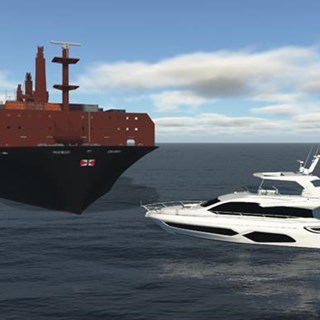
16 October 2024
Artificial Intelligence is reshaping industries across the globe, and naval architecture is no exception. At BMT, we’re exploring how AI can enhance submarine design, not by replacing naval architects, but by equipping them with tools that expand their creative and analytical capabilities. The goal is to explore broader solution spaces, automate repetitive tasks, and support more informed strategic decisions. Ultimately, this means delivering better, faster, and more cost-effective outcomes for our customers.
In the context of submarine or warship design, AI typically refers to machine learning, the ability of algorithms to learn from data and improve over time. While predictive analytics and generative AI also play roles, the real value lies in using data more effectively to tackle the complex and often time-consuming aspects of design. This isn’t about removing human expertise from the process. It’s about augmenting it. AI can take on the heavy lifting of calculations and data processing, allowing naval architects to focus on innovation, insight, and creativity - delivering smarter solutions and more refined designs to our clients.
AI performs exceptionally well when tasked with combining existing content, analysing strategic options, and improving productivity. It can generate technical documentation, forecast trends, and automate workflows. These capabilities translate directly into customer benefits: reduced lead times, improved design accuracy, and enhanced responsiveness to evolving requirements. However, AI still struggles with areas that require subtle judgement, novel thinking, and clarity around ambiguous goals. Validating AI outputs remains a critical step, and this is where human oversight is indispensable.
Rather than thinking of AI as a replacement, it’s more accurate to view it as a highly capable assistant; efficient, consistent, and tireless, but still reliant on expert direction. Like any tool, its effectiveness depends on the quality of its inputs and the skill of the person using it. For our customers, this means confidence that AI-enhanced designs are not only faster to produce but also rigorously reviewed and validated by experienced professionals.
In submarine design, AI is already proving its worth across several key areas. Hullform development is one of the most promising applications. By leveraging panel codes, CFD simulations, and experimental data, machine learning can help designers explore a wider range of hullform variations, optimising performance and efficiency without starting from scratch. This enables us to offer customers more tailored hydrodynamic solutions, faster.
General Arrangement (GA) presents a more complex challenge. Working with UCL’s Bojan Igrec, we’ve investigated how AI can support GA design, not through simple box-packing algorithms, but by navigating the intricate web of interdependencies that define a vessel’s internal layout. While full GA optimisation remains elusive, AI can assist in design building block approaches that reflect human decision-making processes. For customers, this means layouts that better reflect operational needs, with improved space utilisation and access planning.
Structural design is another area where AI can make a significant impact. By analysing frame spacing, bulkhead positions, and detailed components like seating arrangements, machine learning can help identify discontinuities and explore alternative configurations. These tasks traditionally require substantial time and effort, and AI offers a way to accelerate and refine the process. The result for customers is a more efficient design cycle and potentially lower build costs.
Ultimately, the value of AI in submarine design isn’t about saving time during the concept phase, it’s about enabling deeper exploration of the design space. Naval architects must remain creative and critical, identifying limitations and biases in AI-generated outputs. When used thoughtfully, these tools can reveal new opportunities and trade-offs that might otherwise go unnoticed. For our customers, this means access to more innovative, better-informed design options that align with their strategic goals.
As the industry evolves, staying ahead means not only adopting new technologies but also leading the conversation around their use. At BMT, we’re committed to doing both, ensuring our customers benefit from cutting-edge innovation, without compromising on quality, safety, or performance.
Get in touch with our innovation team to learn how BMT’s AI-driven design capabilities can deliver smarter, faster, and more resilient solutions tailored to your operational needs.

Jake is Head of Research & Development, responsible for the portfolio management of internal research projects. This covers a broad range of research topics from ship and submarine design to digital twins and artificial intelligence. Through this role he leads the horizon scanning activities of BMT, tracking external trends and developing the reactive technology roadmaps. He is always on the lookout for the next emerging technology that can revolutionise or incrementally change the way we and our customers operate.
He is a charted engineer and Member of the Royal Institute of Naval Architects originally training as a Naval Architect specialising in ship signatures before his current role of Head of Research & Development. He is a proud member of range of different industry research and technology forums; one of which is the recently formed Maritime Research and Innovation UK (MarRI-UK) for which he leads the “Clean Maritime” research theme. This is an area he is particularly passionate about, investigating how industry, government and academia can work together to provide an economical and sustainable future for the maritime sector.
Jake is also responsible for Academic Engagement at BMT. In recognition of his work to progress Academic Engagement in the maritime sector he was awarded the title of Honorary Associate Professor at the University of Exeter, and continues to engage in a range of collaborative research projects.

N/A
In a world where complexity is the norm and certainty is rare, adaptability isn’t a luxury, it’s a necessity. And when we combine it with empathy, structure, and a commitment to quality, we create programmes that deliver real, lasting value.

N/A
In a world where complexity is the norm and certainty is rare, adaptability isn’t a luxury, it’s a necessity. And when we combine it with empathy, structure, and a commitment to quality, we create programmes that deliver real, lasting value.

Tim Curtis
Most transformation programmes fail—not because of poor execution, but because they never truly understood the race they were competing in. The BMT Strategy Canvas changes that.

Will Roberts
At BMT, we believe simulation is a critical enabler in overcoming these hurdles—de-risking development, accelerating innovation, and building confidence across the entire lifecycle of autonomous systems.